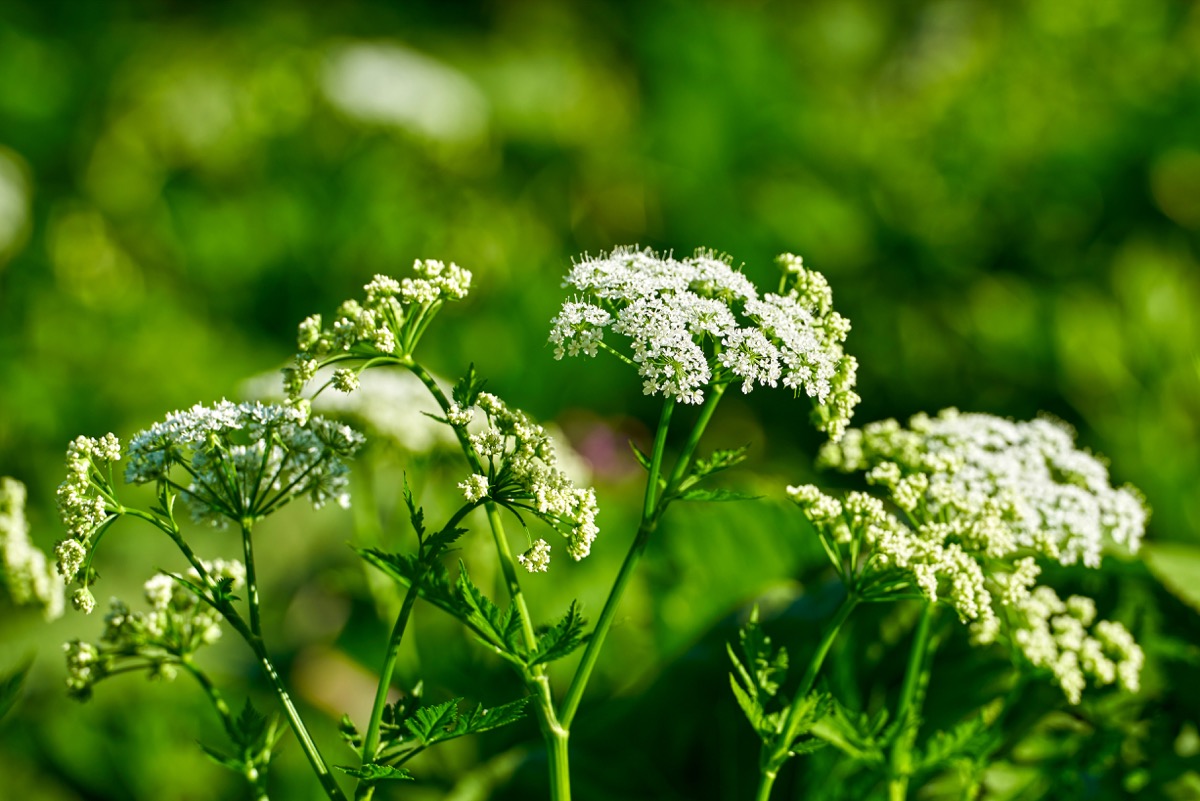If You've Touched This Plant, Call Your Doctor Immediately, Experts Warn
It looks harmless, but can be deadly—and it almost killed an Ohio man.

Spring brings warmer weather, sunny skies, and plants bursting into bloom all over—but you might want to exercise caution when stopping to smell the roses this year. That's because a deadly species of plant is becoming increasingly common across the U.S., and getting too close to it could have disastrous, and even deadly, consequences. One midwestern man found that out firsthand when he had a run-in with the venomous vegetation in his own backyard and ended up in critical condition, unconscious and unable to tell anyone what had happened. Read on to find out what plant to watch out for, the symptoms it can cause, and what to do if you see it.
RELATED: If You See This Flower in Your Yard, Call Local Officials Immediately.
Poison hemlock looks pretty—but touching it could kill you.

You may have heard of hemlock in high school history class—the ancient Greek philosopher Socrates was sentenced to die by drinking it—but what you might not have realized back then is that poison hemlock is actually an innocent-looking plant, covered with pretty white flowers when in full bloom. Gardeners and floral enthusiasts will note that it resembles Queen Anne's lace, which is in fact also toxic, but only mildly so, according to the U.S. Fish & Wildlife Service.
Don't be deceived by poison hemlock's innocuous appearance, however. Part of the Apiaceae family of plants (carrots are a cousin) and with the scientific name Conium maculatum, poison hemlock is one of the most dangerous plants on the planet. What happens if you ingest it? As Healthline explains, common symptoms of hemlock poisoning include trembling, dilated pupils, muscle paralysis, loss of speech, and eventually, respiratory failure and death. But you don't have to eat it to become extremely ill, as an Ohio man recently learned.
RELATED: If You See a Tree That Looks Like This, Call Officials Immediately.
A man in Ohio almost died after encountering poison hemlock while gardening.

The April 2022 issue of Good Housekeeping magazine highlighted the story of Jim LeBlond, a 58-year-old husband and father living in a suburb of Cincinnati, Ohio, who ended up in a medically-induced coma in his local hospital's intensive care unit (ICU) last year, after spending a springtime afternoon clearing his backyard of honeysuckle and weeds. "I saw a lot of white flowers, but I didn't think anything of it," he told the magazine.
LeBlond, who was perfectly healthy before his close encounter with poison hemlock, spent 109 days in the hospital and was close to death. "I was told many times he might not survive," his wife, Jeanne, remembered.
As his doctor, Christopher Hayner, MD, pointed out, LeBlond didn't have to eat the poisonous plant to fall ill. "Anything you can touch, you can also inhale," he explained to Good Housekeeping. When LeBlond used a chainsaw to cut down the hemlock, tiny particles scattered in the air, and when he breathed them in, they almost killed him.
Once relatively uncommon, poison hemlock is now flourishing across the U.S.

Poison hemlock wasn't always as prolific as it is now, so finding it in your backyard is a relatively recent worry. Last year, USA Today reported on the phenomenon: "It just hit this exponential rate of spread," Dan Shaver, Indiana Natural Resources Conservation Service State Forester, told the outlet. "Poison hemlock was nowhere and all of a sudden it was everywhere."
The noxious weed can now be found in nearly every state in the country, according to the United States Department of Agriculture (USDA). "It is not a plant you want around your home or in your local park," Shaver emphasized.
RELATED: For more up-to-date information, sign up for our daily newsletter.
Here's what to do if you think you've been exposed to this poisonous plant.

Though Healthline states that there is no known antidote to hemlock poisoning, if you think you may have touched any part of the plant, breathed in its particles, or been otherwise exposed, you should seek medical attention immediately. Doctors will attempt to treat your symptoms, with an emphasis on securing your airway to help you breathe, and trying to decontaminate your digestive tract to rid your system of the poison.
The best defense, as they say, is a good offense—and in the case of poison hemlock, that means making sure your yard is clear of it, and knowing what it looks like so you can avoid it in the wild. If you do find a suspicious stalk and want to remove it, wear gloves, a face mask, and protective clothing. Dig it out from the roots, rather than cutting it, and never burn it, as the fumes can cause a reaction. If you're unsure what to do, play it safe and consult a professional.
RELATED: If You See These Flowers in Your Yard, Don't Go Near Them, Officials Warn.





















